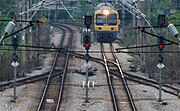Keretapi Tanah Melayu Berhad (KTMB) or Malayan Railway Limited, colloquially referred to simply as KTM, is the main rail operator in Peninsular Malaysia. The railway system dates back to the British colonial era, when it was first built to transport tin. Previously known as the Federated Malay States Railways (FMSR) the Malayan Railway Administration (MRA), and the Malayan Railway, Keretapi Tanah Melayu acquired its current name in 1962. The organisation was corporatised in 1992, but remains wholly owned by the Malaysian government.

The British Rail Mark 3 is a type of passenger carriage developed in response to growing competition from airlines and the car in the 1970s. A variant of the Mark 3 became the rolling stock for the High Speed Train (HST).

KTM Komuter is a commuter rail system in Malaysia operated by Keretapi Tanah Melayu (KTM). It was introduced in 1995 to provide local rail services in Kuala Lumpur and the surrounding Klang Valley suburban areas. Services were later expanded to other parts of Malaysia with the introduction of the Northern and Southern sectors.
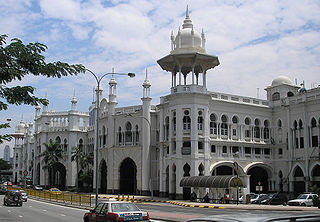
The Kuala Lumpur railway station is a railway station located in Kuala Lumpur, Malaysia. Construction began in 1910 and was fully completed in 1917. It replaced an older station on the same site, the station was Kuala Lumpur's railway hub in the city for the Federated Malay States Railways and its successor Keretapi Tanah Melayu, before Kuala Lumpur Sentral assumed much of its role in 2001. The station is notable for its architecture, adopting a mixture of Eastern and Western designs.

Rail transport in Malaysia has evolved significantly since its inception in the late 19th century, reflecting the country's economic growth and modernization.

The KTM Tanjung Malim–Port Klang Line, formerly known as the Port Klang Line is one of the three KTM Komuter Central Sector lines provided by Keretapi Tanah Melayu. The electric trains run between Tanjung Malim and Port Klang. Prior to 15 December 2015, the northern terminus of this line was Batu Caves.
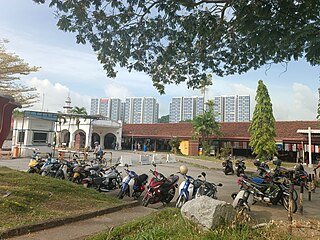
The Seremban railway station is a Malaysian railway station located in the heart of Seremban, the capital of the state of Negeri Sembilan. The station is named after the city.
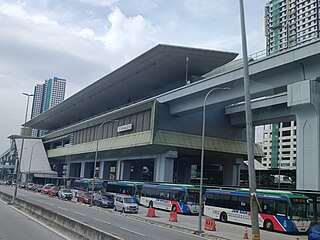
The Kajang railway station is a Malaysian railway station located near and named after the town of Kajang, Selangor. The station is situated 1 km south of Kajang's town centre. However, the MRT Kajang line is also named after the station as well, since it served as a terminus and the final station for the line.

The Class 82 was a type of sub-urban rail electric multiple unit that once operated by Keretapi Tanah Melayu on its KTM Komuter services. Each unit consists of two driving motor cars and a trailer cars. All were retired by 2012 after being replaced by the Class 92.

The Class 83 is a type of electric multiple unit operated by Keretapi Tanah Melayu on its KTM Komuter services. 22 sets were built by Hyundai Precision and Marubeni of South Korea and Japan respectively, in 3-car formations.

The Butterworth railway station is a Malaysian railway station located at and named after the town of Butterworth, Penang.

The Pulau Sebang/Tampin railway station is a Malaysian train station on the West Coast Line located near and named after the bordering towns of Pulau Sebang, Malacca and Tampin, Negeri Sembilan. The station itself is situated in Malaccan territory, being one of the two stations on the West Coast Line that serves the state of Malacca, the other being Batang Melaka.

The KTM ETS, commercially known as ETS, is an inter-city higher-speed rail service in Malaysia operated by Keretapi Tanah Melayu (KTM). The KTM ETS is the second electric train service to be operated by the Malaysian railway company after KTM Komuter, and the second inter-city rail service after KTM Intercity.
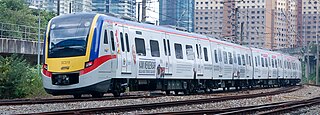
The Class 92 is a type of electric multiple unit operated by Keretapi Tanah Melayu on its KTM Komuter services. A total of 38 sets were built by CSR Zhuzhou of China, in 6-car formations.

The Class 91 is a type of electric multiple unit currently operating on Keretapi Tanah Melayu's Electric Train Service (ETS) since 2009. KTMB purchased a total of 5 sets worth RM 240 million from a joint venture between South Korea's Rotem Co. and Japan Mitsubishi Electric Corp in 2008. Each set has six coaches.

The KTM Batu Caves–Pulau Sebang Line, formerly known as the Seremban Line is one of the three KTM Komuter Central Sector lines provided by Keretapi Tanah Melayu. Its electric trains run between Batu Caves and Pulau Sebang/Tampin. Prior to 15 December 2015, the northern terminus of this line was Rawang.

The Class 93 is a type of electric multiple unit used by Keretapi Tanah Melayu for its intercity Electric Train Service (ETS). A total of 10 sets in 6-car formations have been built and delivered by CRRC Zhuzhou of China, with 9 additional sets ordered in 2019 with delivery finished in 2020. As per the technology exchange agreement, part of the consignment will be partially assembled in Batu Gajah, Malaysia.

The KTM Komuter Northern Sector is one of the five KTM Komuter services run by Malaysian rail operator Keretapi Tanah Melayu (KTM). The service was introduced on 11 September 2015 following the completion of the Ipoh-Padang Besar Electrification and Double-Tracking Project in December 2014, which also saw the extension of ETS services to Padang Besar from Ipoh.

The KTM KL Sentral–Terminal Skypark Line is a currently suspended limited express train service in Kuala Lumpur, Malaysia between Kuala Lumpur Sentral and Sultan Abdul Aziz Shah Airport. It is Malaysia's second airport rail link service, after the Express Rail Link system.
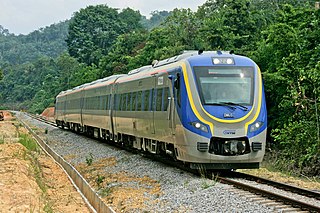
The KTM Class 61 is a diesel multiple unit operated by Keretapi Tanah Melayu for KTM Intercity services on non electrified sections of the KTM West Coast railway line and the KTM East Coast railway line.





